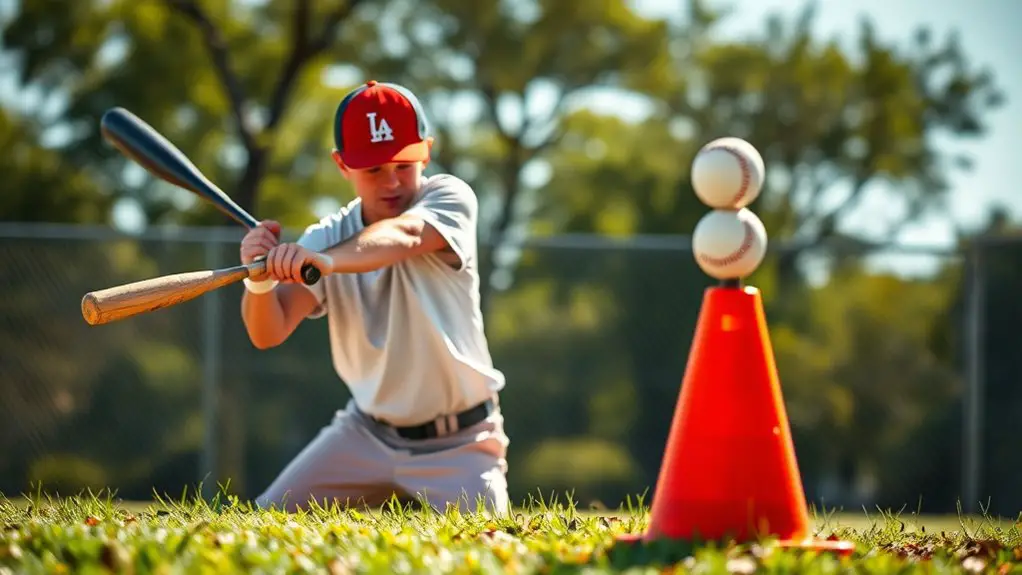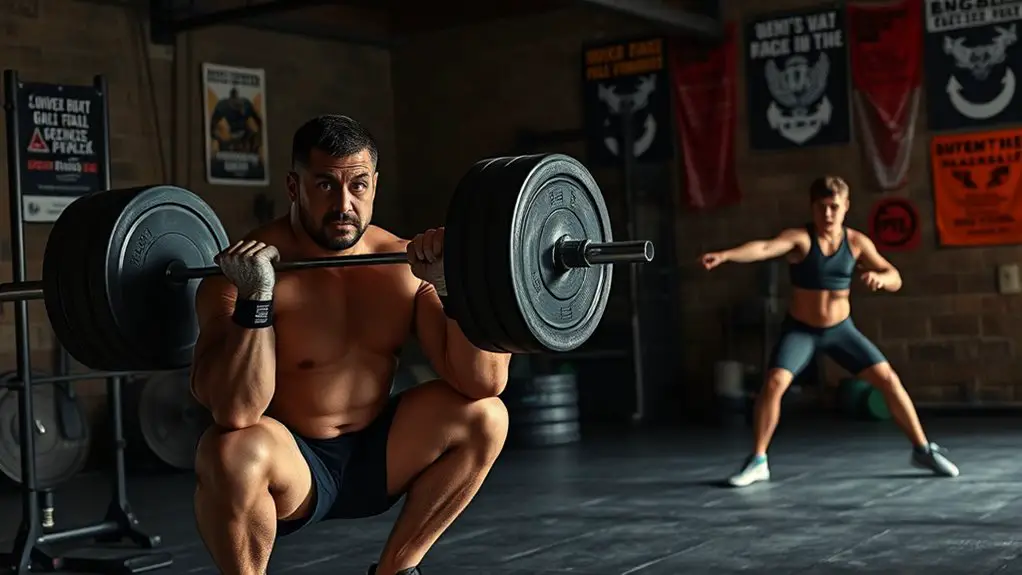To train for rotational explosiveness in baseball, focus on strengthening your core, hips, and shoulders. Incorporate essential drills like medicine ball rotational throws and lighter bat speed drills, which mimic swing motions. Resistance training, including exercises like banded woodchoppers and deadlifts, is vital for building overall strength. Don't forget flexibility and mobility work to enhance your range of motion. With a balanced approach, you'll see improvements in your performance. There's more to uncover to maximize your training.
Understanding Rotational Mechanics in Baseball
To fully grasp rotational mechanics in baseball, you need to understand how your body generates power during swings and pitches. It's all about rotational biomechanics. When you swing the bat or throw the ball, your core acts as the powerhouse. Engaging your hips and torso in sync fuels your swing mechanics, allowing you to release explosive energy.
Think of your body as a coiled spring; the tighter you coil, the more force you can let go. Your lower body generates initial torque, while your upper body follows through, creating a fluid motion that maximizes speed and power. Incorporating squats and lunges into your training routine can significantly enhance your lower body strength, crucial for generating that initial torque.
Key Muscles for Rotational Power
To maximize your rotational power in baseball, focusing on key muscle groups is essential. You'll want to prioritize core stability, engage your hip flexors, and strengthen your shoulder rotators. Understanding how these muscles work together can enhance your performance on the field. Additionally, a strong rotator cuff is crucial for preventing injuries during throwing activities and ensuring optimal performance.
Core Stability Importance
Core stability plays an essential role in enhancing rotational power for baseball players. When you focus on core strength, you're not just building muscles; you're laying the foundation for effective stability training. This stability allows for better force transfer through your body during swings and pitches.
To improve your core stability, consider these key elements:
- Engaging your deep core muscles for balance
- Performing exercises that enhance body awareness
- Incorporating rotational movements to mimic game situations
Hip Flexor Engagement
Hip flexors are essential players in the game of rotational power for baseball. They're the unsung heroes that help you generate explosive movements, whether it's a powerful swing or a quick sprint. To maximize your performance, you need to focus on both hip flexor stretches and hip flexor strengthening. Stretching these muscles keeps them flexible, reducing the risk of injury and allowing for greater range of motion. Meanwhile, strengthening them guarantees you have the power needed for those explosive movements. Incorporate exercises like leg raises and lunges into your routine, alongside dynamic stretches. By engaging and training your hip flexors, you'll reveal the freedom to release your full rotational potential on the field.
Shoulder Rotator Strength
Strong shoulder rotators are critical for achieving ideal rotational power in baseball. Building shoulder stability isn't just about strength; it's about developing your rotator cuff to support powerful movements. By focusing on these key areas, you'll enhance your game considerably:
- Rotator Cuff Exercises: Strengthen those small muscles for better control and stability.
- Dynamic Stretching: Keep your shoulders flexible and ready for explosive movements.
- Core Integration: Engage your core to support your shoulders during rotation.
Incorporating these elements into your training routine will not only boost your performance but also help prevent injuries. Remember, a strong shoulder allows for a fluid, powerful swing, bringing freedom and effectiveness to your game. Embrace the journey and let your shoulders lead the way!
Essential Drills for Rotational Explosiveness
To build rotational explosiveness in baseball, incorporating specific drills into your training regimen is essential. Focus on explosive sequences that engage your core and upper body. One effective drill is the medicine ball rotational throw. Stand sideways to a wall, twist your torso, and throw the ball with maximum effort. This drill mimics the rotational motion in a swing.
Another great option is the bat speed drill, where you perform rapid swings with a lighter bat, emphasizing quick hip rotation. This encourages your body to develop the speed and power needed in your swing.
You can also try the single-leg rotational lift, which enhances balance and strength in your core. Perform this drill by standing on one leg, lifting a weight while rotating your torso. Integrating these rotational drills into your workouts will help you release explosive power, giving you the freedom to excel on the field. Additionally, incorporating compound movements into your training can further enhance your overall athletic performance and core stability.
Incorporating Resistance Training
Building on the explosive movements developed through specific drills, incorporating resistance training can further enhance your rotational power in baseball. By adding weight training and resistance bands to your regimen, you'll build strength that translates directly to your swing and throw. Here's how to make the most of it:
Incorporating resistance training boosts your rotational power, enhancing both your swing and throw in baseball.
- Use resistance bands for rotational exercises, like banded woodchoppers, to engage your core and improve stability.
- Integrate weight training focused on exercises such as medicine ball throws and deadlifts to develop explosive strength.
- Combine lower-body strength training with upper-body exercises for a complete approach, ensuring your whole body works in harmony.
This balanced approach not only builds muscle but also reinforces the fast-twitch fibers necessary for that explosive power you crave. Additionally, focusing on proper technique during your resistance training will enhance lifting efficiency and reduce injury risk. Immerse yourself in resistance training, embrace the freedom it brings, and watch your performance soar.
The Role of Flexibility and Mobility
Flexibility and mobility play an essential role in enhancing your rotational explosiveness on the baseball field. Incorporating dynamic stretching and mobility drills into your routine can greatly improve your performance. Understanding how flexibility impacts your movements can help you release your full potential during games. Additionally, improving your range of motion can further enhance your movement efficiency and reduce the risk of injury while playing.
Importance of Dynamic Stretching
Dynamic stretching plays an essential role in enhancing your flexibility and mobility, which are crucial for achieving rotational explosiveness in baseball. By incorporating dynamic warm ups into your routine, you'll prepare your body for the explosive movements needed on the field. Here's why dynamic stretching is key:
- Boosts your range of motion, allowing for better swing mechanics
- Increases blood flow to muscles, promoting peak performance
- Supports injury prevention by preparing your body for intense activity
Embracing dynamic stretching not only improves your physical capabilities but also instills a sense of freedom in your movements. So, make it a priority in your training regimen, and watch your rotational power soar as you step up to the plate.
Mobility Drills for Rotation
After incorporating dynamic stretching into your routine, it's time to focus on mobility drills that enhance your rotational abilities. Improving your hip mobility and thoracic rotation is essential for generating power in your swing. Try exercises like the world's greatest stretch and seated thoracic rotations. These movements not only increase your range of motion but also help you connect your lower and upper body during rotation. Incorporate a resistance band for added challenge, and don't forget to warm up your hips with lunges and hip circles. As you work on these drills, you'll notice increased fluidity in your movements, allowing you to release your full potential at the plate. Embrace this freedom of movement, and watch your game elevate!
Flexibility's Impact on Performance
While you may focus on strength and technique, neglecting flexibility can greatly hinder your performance on the field. Embracing flexibility not only enhances your range of motion but also improves your overall athleticism. Here are some key flexibility benefits to take into account:
- Increased power during rotational movements
- Reduced risk of injury
- Enhanced recovery after intense workouts
Incorporating flexibility training into your routine can lead to significant performance enhancement. When your muscles and joints move freely, you can generate more explosive power, essential for hitting and pitching. So, don't just lift weights—stretch, flow, and allow your body the freedom to perform at its best. Make flexibility a priority, and watch your game reach new heights!
Creating a Balanced Training Program
To develop rotational explosiveness in baseball, it's essential to create a balanced training program that addresses strength, flexibility, and skill-specific drills. Start by incorporating strength training exercises focused on your core, legs, and upper body to enhance your power during swings. Don't forget to include flexibility routines to improve your range of motion and prevent injuries.
Balanced nutrition is also important; fuel your body with the right mix of proteins, carbs, and healthy fats to support your training and recovery. Adequate protein intake shouldn't be overlooked either, as it is crucial for repairing damaged muscle fibers post-exercise.
Moreover, integrate recovery strategies into your schedule, like foam rolling and adequate rest days, to help your muscles recover and adapt. By combining these elements, you'll not only improve your rotational explosiveness but also enjoy a more fulfilling training experience. Embrace this freedom in your approach, and you'll see your performance on the field soar.
Frequently Asked Questions
How Often Should I Train for Rotational Explosiveness?
When considering how often you should train for rotational explosiveness, frequency recommendations typically suggest 2-3 times a week. This allows you to balance intensity with recovery, keeping your body fresh and ready. It's essential to listen to your body and adjust your training schedules accordingly. Embrace the freedom to experiment with different routines, ensuring they fit your lifestyle while still challenging your abilities. Consistency is key, so find what works best for you!
Can I Train Rotational Explosiveness at Home?
Can't you just love the idea of training at home? You absolutely can train for rotational explosiveness right in your living room! Bodyweight exercises like Russian twists, medicine ball slams, and planks can be incredibly effective. A home workout not only saves you time but also lets you focus on your own pace. Just make sure to stay consistent, and you'll see progress without ever stepping into a gym. Freedom in fitness is yours!
What Equipment Do I Need for These Drills?
To train effectively for rotational explosiveness, you'll need some essential equipment. Weighted balls are fantastic for building strength and power in your throws. They'll help you feel the difference in your technique. Resistance bands are another great tool; they provide versatile resistance for various drills, enhancing your muscle engagement. With these items, you can create a dynamic training environment at home, giving you the freedom to work on your explosiveness whenever you want.
How Long Before I See Results?
You might wonder about your results timeline, and it really depends on your training frequency. If you're consistent and dedicated, you could start noticing improvements in just a few weeks. Everyone's body responds differently, though, so don't rush the process. Enjoy the journey and celebrate small wins along the way. Keep pushing yourself, and you'll see how your hard work pays off—freedom comes from progress, after all!
Are There Age Restrictions for Training Explosiveness?
There aren't strict age restrictions for training explosiveness, but it's essential to take into account youth training safety guidelines. Kids can start basic exercises as early as their pre-teen years, focusing on body awareness and coordination. As they grow, you can gradually introduce more advanced drills. Always prioritize proper form over intensity to avoid injuries. Remember, fostering a love for movement is just as important as building explosiveness, so keep it fun!




